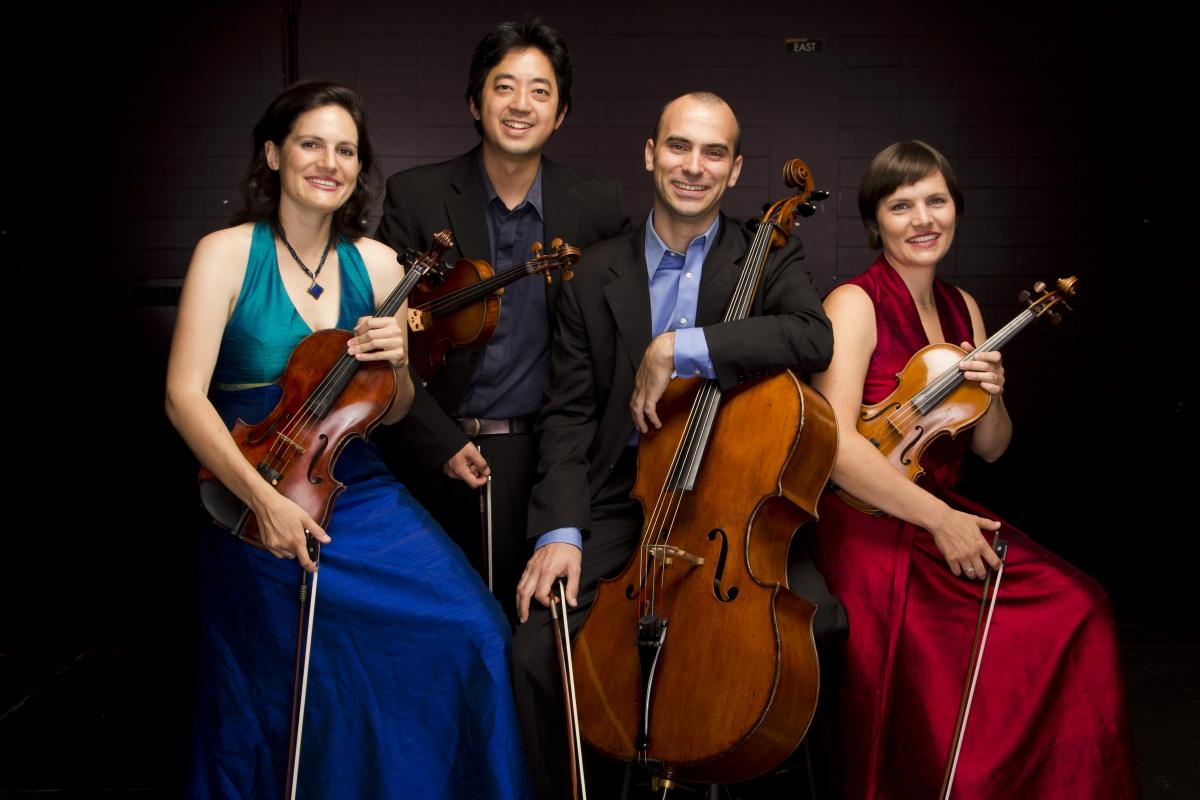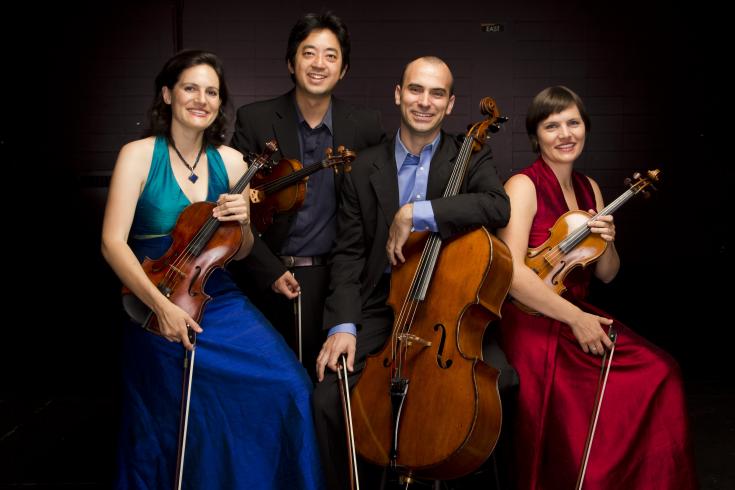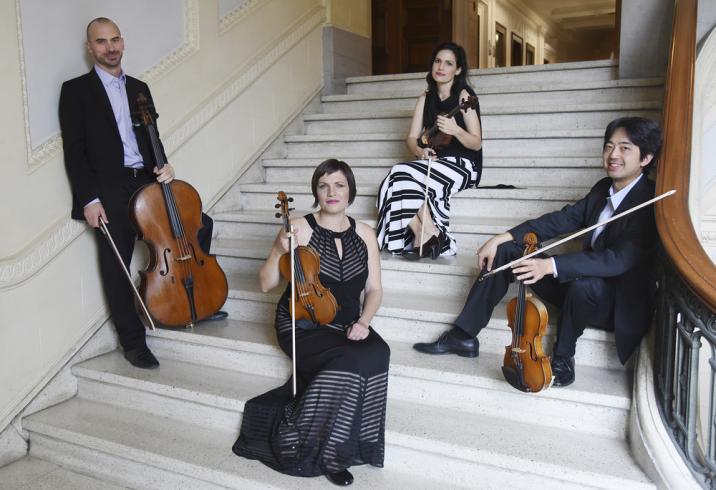Jupiter Quartet
String Quartet

The Jupiter Quartet will perform their Phillips debut with selections by Mozart, Bartók, and Schumann.
Program
Formed in 2001, the Jupiter Quartet first came to prominence as the winner of the Banff International String Quartet Competition and through its subsequent residency with the Chamber Music Society of Lincoln Center. The quartet has played all over the world and has commissioned several new works. The Jupiter Quartet is currently the Quartet in Residence at the University of Illinois at Urbana-Champaign. This program includes the first of Mozart’s great set of quartets dedicated to Haydn, the most daring and experimental of Bartok’s quartets, and the most ardent and lyrical of the quartets by Schumann, dedicated to his friend Mendelssohn.
PROGRAM:
WOLFGANG AMADEUS MOZART (1756-1791)
String Quartet No. 14 in G Major, K. 387 (1782)
Allegro vivace assai
Menuetto
Andante cantabile
Molto allegro
BÉLA BARTÓK (1881-1945)
String Quartet No. 4 (1928)
Allegro
Prestissimo, con sordino
Non troppo lento
Allegretto pizzicato
Allegro molto
Intermission
ROBERT SCHUMANN (1810-1856)
String Quartet No. 3 in A Major, Op. 41/3
Andante espressivo - Allegro molto moderato
Assai agitato
Adagio molto
Finale. Allegro molto vivace - Quasi Trio
About the Artists
The Jupiter String Quartet is a particularly intimate group, consisting of violinists Nelson Lee and Megan Freivogel, violist Liz Freivogel (older sister of Meg), and cellist Daniel McDonough (husband of Meg, brother-in-law of Liz). As they enter their thirteenth year of making music together, the members of this tightly-knit ensemble have firmly established their quartet as an important voice in the world of chamber music. In addition to their performing career, the Jupiters are the String Quartet-in-Residence at the University of Illinois in Champaign-Urbana, where they maintain private studios as well as responsibility for running the chamber music program.
The Quartet concertizes across the United States, Canada, Europe, Asia, and the Americas. They have enjoyed playing in some of the world’s finest halls, including New York’s Carnegie Hall and Lincoln Center, London’s Wigmore Hall, Boston’s Jordan Hall, Mexico City’s Palacio de Bellas Artes, Washington, D.C.’s Kennedy Center and Library of Congress, Austria’s Esterhazy Palace, and Seoul’s Sejong Chamber Hall. They have also been enthusiastically received at many major music festivals, including the Aspen Music Festival (where they performed their first complete Beethoven quartet cycle), West Cork (Ireland) Chamber Music Festival, Caramoor International Music Festival, Music at Menlo, Maverick Concerts, Madeline Island Music Festival, Rockport Music Festival, the Banff Centre, Yellow Barn Festival, Skaneateles Festival, and the Seoul Spring Festival, among others.
The Jupiters have been fortunate to receive several chamber music honors over the course of their career. In 2008 they were awarded an Avery Fisher Career Grant and, in 2007, they were given the Cleveland Quartet Award from Chamber Music America. Previously, the Jupiters were awarded first prize in the Banff International String Quartet Competition (where they also received the Szekely Prize for best performance of a Beethoven quartet), and grand prize in the Fischoff National Chamber Music Competition. The quartet’s career began to take off after being selected in the Young Concert Artists International auditions in 2005. From 2007-2010, the Quartet was in residence at the Chamber Music Society of Lincoln Center’s Chamber Music Two and, in 2009, they received a grant from the Fromm Foundation to commission a new quartet from Dan Visconti for a CMSLC performance at Alice Tully Hall.
The Jupiters’ relationship with CMSLC continued with a series of performances alongside vocalist Thomas Hampson, including a new commission for quartet and voice by Mark Adamo. The quartet also helped to commission a new quartet by the composer Hannah Lash, which they premiered at the Great Lakes and Aspen Music Festivals. Current projects include a second Beethoven cycle, this time at the Massachusetts Institute of Technology, a Bartok cycle (to premiere at the University of Illinois) and two upcoming recording projects, the first of which will include Visconti’s string quartet as well as the Dvorak “American” quartet–interspersed with a selection of spirituals arranged for voice and quartet. The Jupiters just finished a multi-year visiting residency at the Oberlin Conservatory, and will continue their regular series of concerts as resident quartet at the beautiful Krannert Performing Arts Center in Champaign-Urbana.
In addition to its formal concert schedule, the Jupiter String Quartet places a strong emphasis on developing relationships with future classical music audiences through outreach work in school systems and other educational performances. They believe that chamber music, because of the intensity of its interplay and communication, is one of the most effective ways of spreading an enthusiasm for “classical” music to new audiences.
Indeed, it was early exposure to chamber music that brought these four musicians to form the Jupiter String Quartet. Meg and Liz grew up playing string quartets with their two brothers, Ben and J. Rehearsals were often quite raucous, but they grew to love chamber music during weekly coachings with Oliver Edel, a wonderful cellist who taught generations of students in the Washington, D.C. area. Nelson also comes from a musical family–both of his parents are pianists (his father also conducts) and his twin sisters, Alicia and Andrea, are both musicians. Although Daniel originally wanted to be a violinist, he ended up on the cello because the organizers of his first string program declared that he had “better hands for the cello.” He remains skeptical of this comment (he was, after all, only five), but is happy that he ended up where he did.
The quartet has recorded works by Mendelssohn, Beethoven, Shostakovich, and Britten for Marquis Records. American works by Barber, Seeger, and Gershwin were also recorded for iTunes in conjunction with the Chamber Music Society of Lincoln Center and Deutsche Grammophon. Most recently, they collaborated on a collection of works by Ravel (Ravel: Intimate Masterpieces) on the Oberlin College label. Two upcoming recordings are in the works on the Azica label this season.
The quartet chose its name because Jupiter was the most prominent planet in the night sky at the time of its formation and the astrological symbol for Jupiter resembles the number four.
Notes
W. A. Mozart, String Quartet in G Major, K. 387 (1782)
Mozart’s String Quartet in G Major was the first of the six celebrated quartets Mozart dedicated to Joseph Haydn, and was completed on the last day of 1782. It had been a momentous year in the composer’s life. The premiere of the opera The Abduction from the Seraglio had established him as a significant musical presence in his new home of Vienna. Soon afterwards, he was married to Constanze Weber in St. Stephen’s Cathedral. It was the beginning of a new life with new challenges and opportunities. Mozart began working on a series of Piano Concertos as well as a set of six string quartets that he planned to dedicate to Haydn, who had recently published six quartets under the Opus number 33 (1781), declaring that they were written “in a new and special way.” By this Haydn meant, among other things, the absolute equality of the four instruments and a more rigorous way of developing the themes. Mozart’s six ‟Haydn” quartets were his response to these innovations, and they involved “long and arduous work,” as the younger composer admitted in his dedicatory letter to “my dear friend Haydn.”
The way the G Major quartet combines simplicity and sophistication is nothing short of miraculous. The melodies unfold with natural ease yet, upon closer look, they exhibit an extraordinary richness of harmonic and textural detail. There is an abundance of thematic ideas, and Mozart finds adventurous ways of developing and transforming them in the course of the first movement. Yet the surprises are only beginning. The second movement minuet expands that simple dance into a full-fledged Sonata form: a rather complex first theme, with accents in unusual places, is followed by a contrasting second melody, a brief but remarkable development, and a varied recapitulation. The trio or middle section, unexpectedly begins with a dramatic outburst and continues with a gripping lament, all in Mozart’s “tragic” key of G minor.
The Andante cantabile is one of Mozart’s most intimate slow movements. Embellishments and elaborate figurations are an integral part of its melodic material, lending a great deal of extra weight to the one special moment where the ornamentation temporarily stops and a rather unusual series of modulations is initiated by the unaccompanied cello.
The last movement begins like a fugue; its four-note theme even bears some resemblance to the famous theme of the Jupiter symphony’s fugal finale. Yet the counterpoint is only intermittent: it alternates with other themes of great simplicity, including one remarkable passage that anticipates the second-act quintet from The Magic Flute, one of Mozart’s last works. The central portion of this finale contains one of the most harmonically daring sequences Mozart ever wrote. All in all, it is a rather dynamic movement, yet it ends gently, with a coda that concludes in a rather unassuming, understated manner.
Béla Bartók, String Quartet No. 4 (1928)
The string quartets of Béla Bartók have long been recognized as one of the peaks of 20th-century chamber music. In these six masterworks, Bartók created a classical sense of harmony and balance using entirely new and non-classical means—an achievement to which few of his contemporaries can lay claim.
The five-movement layout of Quartet No. 4, with two thematically related fast movements in the first and fifth place, respectively, two scherzo-type pieces (also related) as movements No. 2 and 4, and an emotionally intense central slow movement is an example of Bartók’s fondness for classical symmetries. These symmetrical structures are filled out with extraordinary timbral and textural imagination, as frequent double and triple stops, tremolos, glissandos, and other technical devices add their dramatic contributions to musical form. The breathtaking coda of the first movement (Più mosso, “Faster”) caps a movement that is powerful and exciting from the start.
In the second movement (Prestissimo, con sordino) all four instruments keep their mutes on throughout. Much of this dashing and mysterious Scherzo consists of chromatic scales scurrying up and down. Only in the middle section does a “theme” (a musical idea with a sharp rhythmic and melodic profile) emerge, only to be buried again in a vibrant texture of glissandos, harsh chords, and rapid chromatic scales.
The third movement, the centerpiece of the work, begins with an expressive cello solo, played in a precisely notated rhythm that nevertheless gives the impression of tempo rubato (free rhythm). Commentators have seen in this passage a reflection (though not a direct recreation) of the hora lungǎ, an improvisatory form in Romanian folk music that was particularly important to Bartók because it seemed to have parallels in many other countries. The extended cello solo eventually yields to an anguished passage led by the first violin, reaching an Agitato climax. When the original tempo resumes and the cello reclaims its leading role, it receives a counterpoint from the first violin, and the rubato rhythm becomes more regular, as if “tamed” by the intervening events. Yet the last word belongs to the anguished micro-motifs of the first violin.
The fourth movement takes up the ascending and descending scales of movement two, yet the chromatic scale is now stretched out to diatonicism (many of the half-steps widened to whole steps). Again, a special playing technique is called for, but instead of the mutes used in the second movement, this time the four players put down their bows and use pizzicato (plucked strings) throughout. Sometimes these pizzicatos are of the variety known as the “Bartók” pizzicato, in which the string is plucked so strongly that it rebounds off the fingerboard. The rhythmic complexity of the movement is considerable, yet the overall impression is a humorous one.
The last movement, based on the same thematic material as the first, regularizes the rhythmic structure so that the melody fits into a dance pattern with phrases of equal length, which was not the case before. The accompaniment, with strong offbeat accents and playful grace notes, greatly enhances the dance mood. The high jinks are only briefly halted by a light and graceful melodic episode; the wild dance soon returns and culminates in a concluding passage that recalls the ending of the first movement almost literally.
Robert Schumann, String Quartet in A major, Op. 41, No. 3 (1842)
The year of 1842 was Schumann’s “chamber music year,” just as 1841 was his “symphonic year,” and 1840 his “lieder year.” At this crucial point in his career, the composer who until then had concentrated on solo piano music made a conscious effort to conquer the other major musical genres of the time. This expansion in Schumann’s creative output certainly wouldn’t have happened without another fortunate “conquest”: on September 12, 1840, he married Clara Wieck after a courtship of many years, during which the couple had to overcome numerous obstacles due to the vigorous objections of Friedrich Wieck, Clara’s father and Robert’s former piano teacher.
The long-awaited union with his beloved released enormous creative energies in Schumann. In 1842 alone, he completed his three string quartets (Op. 41), his Piano Quintet (Op. 44) and Piano Quartet (Op. 47), in addition to the Fantasiestücke for Piano Trio (Op. 88). It was an enormous amount of work, accomplished amidst the demands of a growing family and between bouts of the severe depression that had plagued him since his youth.
Schumann dedicated his three string quartets to his close friend Felix Mendelssohn who spoke of them with the greatest admiration: in fact, Schumann may be said to have taken the string quartet (perhaps the hardest of all musical genres) by storm, producing three highly original masterworks that speak in the composer’s unmistakable personal voice.
Everything in the first movement of the A Major quartet seems to grow out of a germinal motif of only two notes—a drop of a perfect fifth from the sixth degree of the scale to the second. This gentle idea underlies both the first and the second themes, provides the starting point for an ingenious development, and dominates the recapitulation until, in the very last measure, the cello answers it with another descending perfect fifth, this time from the dominant to the tonic, providing a closure that is entirely natural and yet surprising in its context.
The second movement begins with an Agitato theme followed by a set of variations in turn animated, fugal, lyrical, and energetic; yet the high point of the movement may well be the coda with its sudden jumps to distant keys and a magical texture in which the first violin and the cello “sing” the melody as a duet while the inner voices play an animated accompaniment.
After a heartfelt Adagio, whose expressive melody is elaborated with a great deal of sophistication, the work culminates in a complex rondo finale in which all the themes (not only the rondo theme but the episodes as well) return multiple times, and in a new key every time. Thus, the movement traverses an unusually large number of tonalities as several different musical characters are explored, from the dynamic dotted figure of the opening theme to a gentler second episode and then a section marked Quasi Trio which, at least initially, resembles a Baroque Gavotte. Once more, Schumann saves one of the most striking moments for last, concluding as he does with a coda where the excitement and intensity of the music surpasses everything heard before.
Peter Laki, 2017

